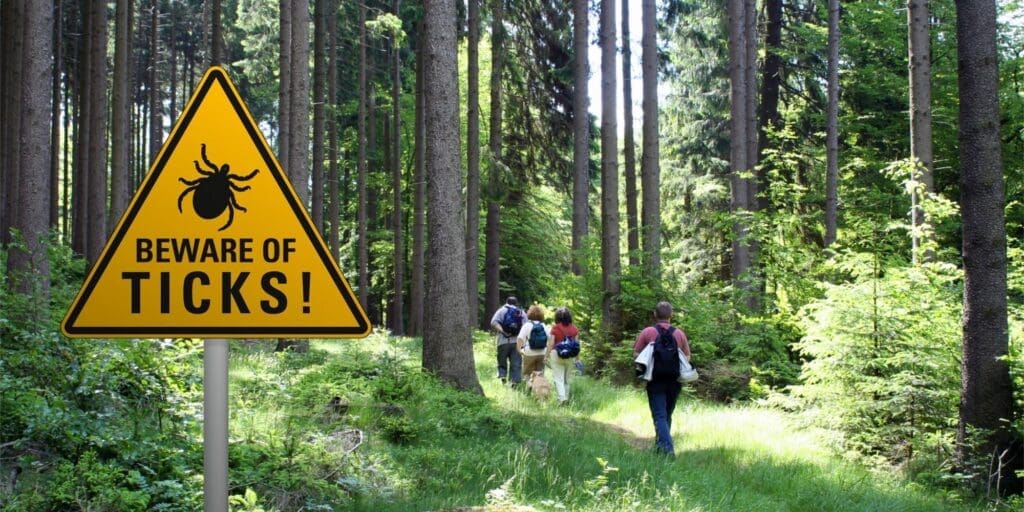With the summer solstice in the rear view mirror, the longest day of the year may be behind us, but the coming months of warm weather bring with them an unwanted sidekick: tick season. For many, the warmer weather and summertime festivities are welcome opportunities to spend time outdoors. And, while nobody wants to spend summer indoors, some may be wary about venturing outdoors during tick season. In this article, we’ll cover everything you need to know about tick season when it starts when it ends, and how you can soak up the sun safely while avoiding ticks. Let’s first start by understanding when tick season starts, and when it ends.
When Is Tick Season?
For the majority of the U.S., tick season starts in early spring and continues through late summer and early fall. While some species of ticks remain active in the colder winter months, most will become dormant during this time. However, as temperatures begin to rise, those ticks that have been dormant for months become active and will start to search for a host.
This reactivity period marks the beginning of tick season, which typically begins around early spring or mid-March. Since early spring is also when people begin spending more time doing outdoor activities, such as hiking and gardening, it can put them at an even higher risk of running into a tick.
Tick season continues throughout the hotter months of the year, and will peak sometime around August. Peak tick season typically lasts from May through August. With the arrival of the tick nymphs in May and the warm summer weather, there are more ticks out looking for a blood meal during this time.
As the summer ends, and the weather begins to cool down, ticks become less active. In most areas of the U.S., tick season ends once temperatures drop below freezing. Most species of ticks will die off when this happens, although other species, like the deer tick, are better adept at surviving during the winter, and can still be active.
Why Staying Safe During Tick Season Matters

Ticks carry bacteria that can cause a host of diseases, many of which can cause severe symptoms, and in some cases even death. These diseases are so common, in fact, that one study found nearly 14% of the world’s population has been affected by Lyme disease alone. Along with Lyme disease, there has been a recent spike in reported cases of other, new diseases popping up, all of which appear to be on the rise.
It’s not just the bite and immediate symptoms that follow that you should be concerned about. Some tick-borne diseases, like Powassan virus, can also lead to serious long-term health effects and complications which themselves can be deadly.
Illness-causing ticks can be found in all 50 states, which is why raising awareness, staying safe, and avoiding tick bites is important for everyone, no matter where you live.
Common Tick-Borne Diseases
There are many different species of ticks, which means there are also many different types of tick-borne illnesses. Some of these illnesses can only be carried and transmitted by a single species, like anaplasmosis which is transmitted only via the black-legged tick (deer tick). Other illnesses, like the Powassan virus, have been known to be transmitted by multiple species of ticks, such as the deer tick and groundhog tick.
Understanding the different types of tick-borne illnesses, along with what species of ticks transmit them, can help you stay safe during tick season. Below is a list of some of the most common tick-borne illnesses, starting with the most common: Lyme disease.
Lyme Disease
Lyme disease is by far the most well-known, and most common, type of tick-borne illness. Caused by a type of bacterium known as Borrelia burgdorferi, Lyme disease is a potentially serious bacterial infection affecting both humans and animals. It is the most commonly reported type of tick-borne disease in all 50 states, and as previously mentioned, is prevalent in many other countries around the world.
While there have been instances of Lyme disease being caused by other species of ticks, it is almost exclusively transmitted by deer ticks.
Anaplasmosis
Formerly known as human granulocytic ehrlichiosis (HGS) anaplasmosis is a bacterial disease caused by the bacterium Anaplasma phagocytophilum. This disease was first recognized as a human disease in the mid-1990s but did not become a reportable disease until 1999. Primarily spread by the blacklegged tick and western blacklegged tick, anaplasmosis typically causes symptoms such as fever, headache, chills, and muscle aches.
While less common than Lyme disease, anaplasmosis is still a very real threat during tick season.
Babesiosis
Babesiosis is a rare, oftentimes life-threatening, infection of the red blood cells that is caused by a bite from an infected deer tick. The type of bacteria that most often affects humans is called Babesia microti, and typically causes symptoms within 1 to 8 weeks after you come in contact with the tick that causes the disease.
Ehrlichiosis
Ehrlichiosis is another common tick-borne disease caused by the bacterium Ehrlichia chaffeensis. This disease is found throughout most of the south-eastern and south-central U.S. and is not common in the eastern and northern parts of the country. Ehrlichiosis due to Ehrlichia muris subspecies eauclairensis was first reported in 2009.
Powassan Virus
Powassan virus is a tick-borne flavivirus (a type of RNA virus) that is related to some mosquito-borne viruses like West Nile virus. Unlike other tick-borne illnesses, Powassan virus, as the name suggests, is caused by a viral infection rather than a bacterial one. While still very rare in the U.S., Powassan virus is most commonly transmitted by deer ticks. The virus is named after Powassan, Ontario where it was first discovered in 1958. Most cases of Powassan virus occur in the Northeast and Great Lakes regions and are most commonly reported in late spring through early fall when ticks are most active.
Rocky Mountain Spotted Fever (RMSF)
RMSF is thought to be the most deadly tick-borne disease in the world, and will often lead to permanent damage in survivors. This disease is transmitted by the American dog tick, which is primarily found east of the U.S. Rocky Mountains and in some areas of the Pacific Coast. The brown dog tick and other tick species are associated with RMSF in Central and South America.
Now that we’ve covered some of the most common types of tick-borne illnesses, it’s time to talk about how to stay safe during tick season.
How To Stay Safe During Tick Season


While ticks can be active year-round, most are active during the warmer months from April through September. This also happens to be when we are most active, which shouldn’t come as a surprise. Whether you’re out gardening, walking, hiking, having a picnic, or just enjoying some time outside in your backyard, understanding how you can stay safe during tick season is vital.
Below are five simple ways you can enjoy the outdoors this summer while also avoiding ticks.
Know Where To Expect Ticks
The first and most important step in staying safe during tick season is to understand the area you live in. Taking a few minutes to learn which ticks are most common in your area can help you better avoid areas where ticks may be more active. Once you’ve done that, you can next know where in your area you can expect to encounter ticks.
Across almost all of the U.S., ticks typically live in grassy, brushy, or wooded areas, or even on animals. Spending time outside walking your dog, camping, gardening, or hunting could bring you in close contact with ticks. Many people get ticks in their own yard or neighborhood.
When choosing where to spend time outside, avoid, if possible, tall grass, dense vegetation, or heavily wooded areas.
Treat Your Clothing
After checking your surroundings, it’s time to treat your clothing with a product known as permethrin. Permethrin is both a medication and an insecticide. As a medication, it is used to treat scabies and lice. It is applied to the skin as a cream or lotion. As an insecticide, it can be sprayed onto clothing or mosquito nets to kill the insects that touch them.
The Centers for Disease Control and Prevention (CDC) recommends treating your clothing with products containing 0.5% permethrin. Permethrin can be used to treat boots, clothing, and camping gear and remain protective through several washings. Alternatively, you can buy permethrin-treated clothing and gear.
Use Environmental Protection Agency (EPA)-Approved Insect Repellents
While treating your clothing with permethrin is an effective way to avoid ticks, it may not always be enough. Along with permethrin, using insect repellents that have been approved by the EPA is highly recommended when spending time outdoors during tick season.
Products containing DEET, picaridin, IR3535, Oil of Lemon Eucalyptus (OLE), para-menthane-diol (PMD), or 2-undecanone are all recommended by the CDC for tick prevention. If you’re unsure about an insect repellent you own, if you need guidance on what products are best for you, the EPA has a great search tool you can use.
Check Your Body and Clothing After Coming Back Indoors
Even with the right preventative measures, ticks can still find their way onto your body. Ticks may be carried into your home either on your clothing or your body, which is why it’s important to check yourself immediately after returning indoors. In most cases, ticks need to be attached to your body for anywhere from 36 to 48 hours or more to transmit diseases.
When you return to your home, check your clothing for any ticks that may have attached themselves. Any ticks that are found should be removed and disposed of. If you can’t remove them, you can tumble dry your clothes in a dryer on high heat for 10 minutes to kill ticks on dry clothing. If your clothing is wet, leave them out to dry before checking for ticks.
Once you’ve checked your clothing, move on to checking your body for any ticks that may have found their way through. Ticks are smart and will try to attach themselves to areas of your body that are particularly hard to check, so an extra pair of eyes is always recommended. Common areas you may find ticks include:
- Under the arms
- In and around the ears
- Inside belly button
- Back of the knees
- In and around the hair
- Between the legs
- Around the waist
Understanding how to stay safe during tick season goes much further than simply avoiding areas of tall grass. Since some ticks attach themselves to animals or other humans, they can travel into places you may otherwise think are tick-free. This includes places like parks, coastal areas, beaches, and even your backyard. So, when spending time outdoors this summer, understand what ticks live in your area, avoid heavily wooded or grassy areas, use insect repellent, and check yourself after returning home.
What Tips Do You Have on How To Stay Safe during Tick Season?
Let us know in the comments below!
What topics related to tickborne diseases should we cover next?
Email us your ideas at info@painresource.com!
Are you or someone you know living with a tickborne disease? Are you looking for a support group?




